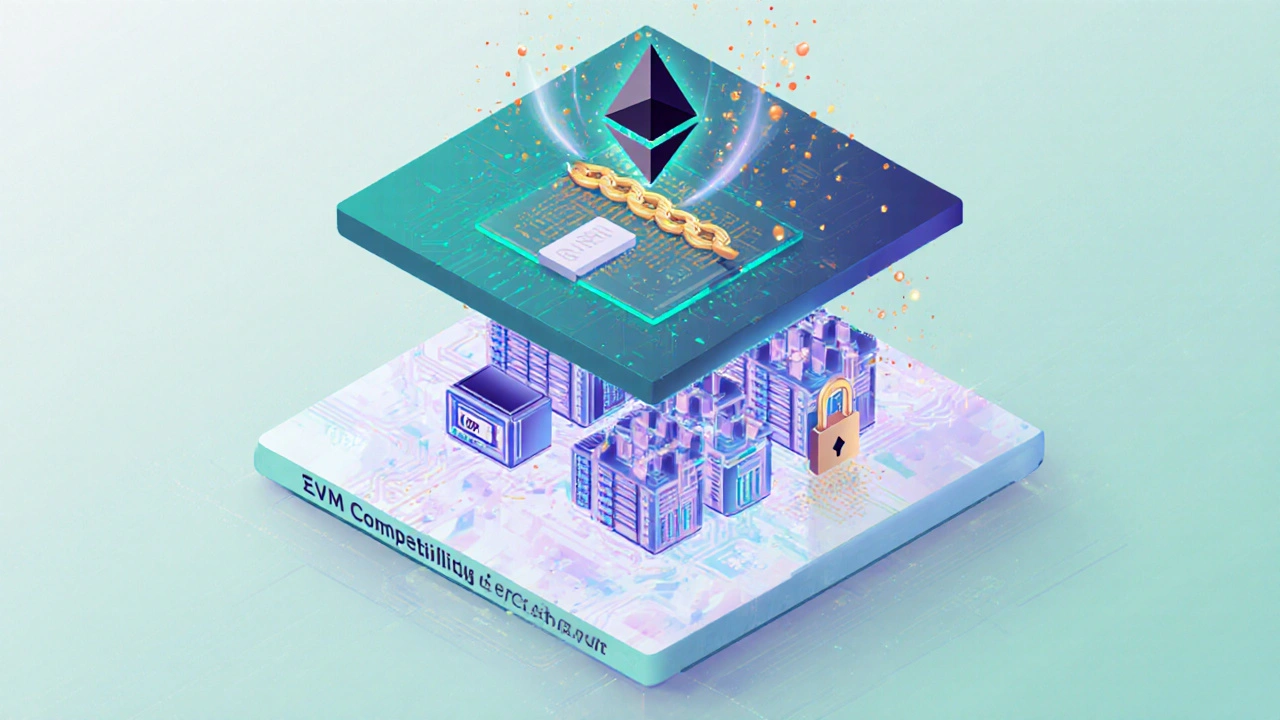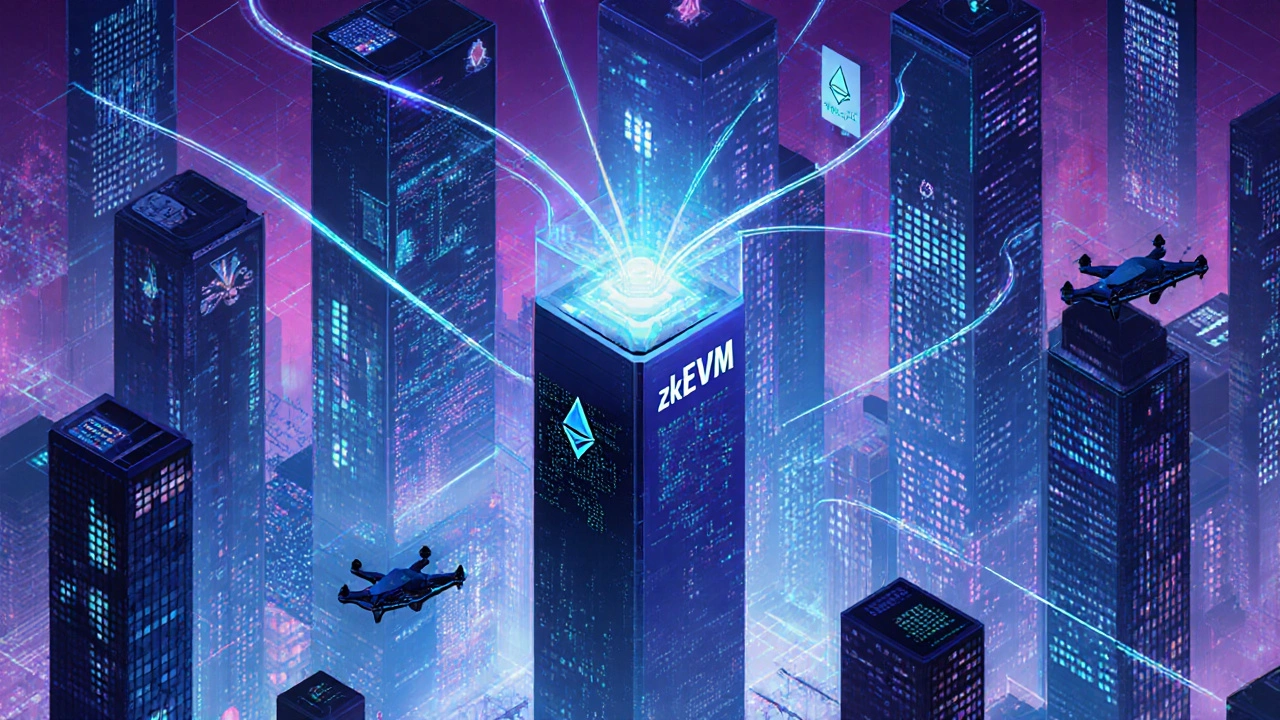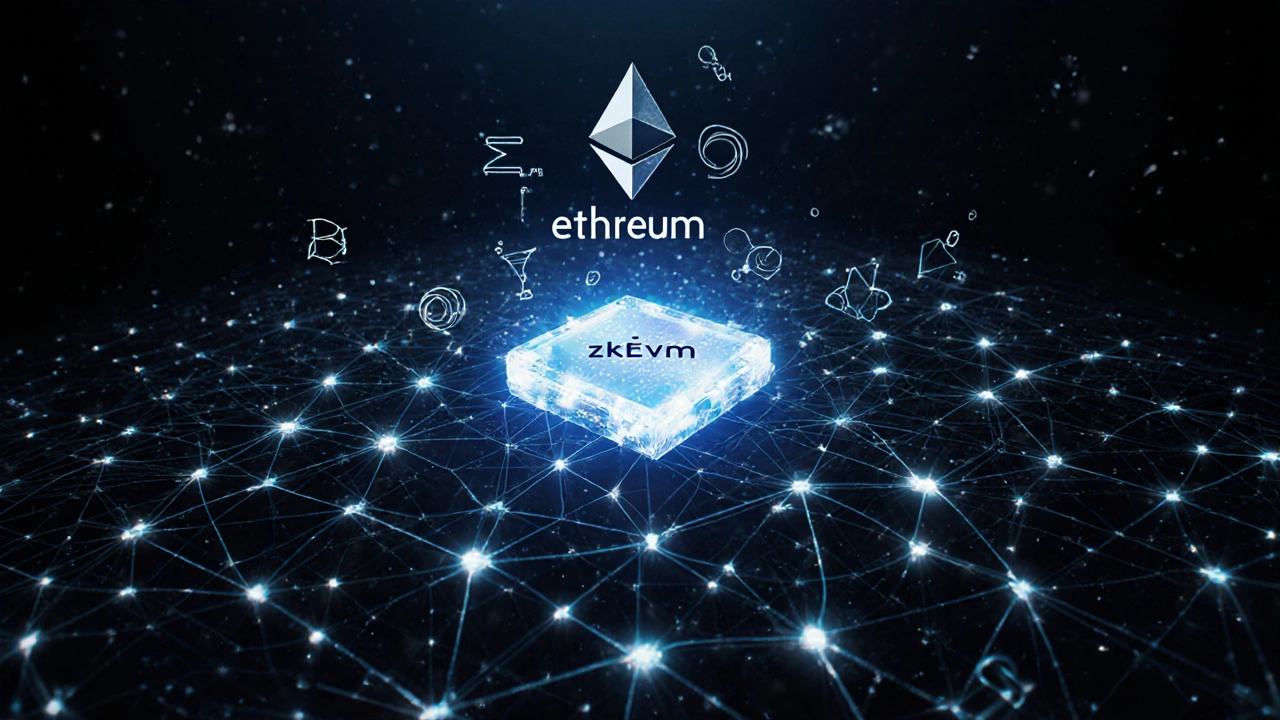Ever wondered why some Ethereum‑compatible chains can process thousands of transactions per second while still keeping the same security guarantees? The secret lies in zkEVM, a zero‑knowledge version of the Ethereum Virtual Machine that packs the best of Ethereum’s developer experience with the scalability of roll‑up technology. This guide walks you through exactly how zkEVM works, why it matters, and what you can expect when building on it.
What is zkEVM?
zkEVM is a zero‑knowledge roll‑up that runs smart contracts exactly like the Ethereum Virtual Machine (EVM) while generating cryptographic proofs to validate state transitions. It aims for full EVM compatibility, meaning developers can deploy Solidity code without changes, but the underlying execution happens off‑chain and is verified on‑chain via a succinct proof.
Zero‑Knowledge Proofs in a Nutshell
Zero‑knowledge proofs let one party prove that a computation was done correctly without revealing any intermediate data. In the zkEVM world, the most common proof systems are zkSNARKs and zkSTARKs. Both produce a short proof that can be checked by any Ethereum node in a few milliseconds, yet the expensive heavy‑lifting of the computation is performed by a specialized prover.
Core Architecture of a zkEVM
Think of a zkEVM as three layers glued together:
- EVM Compatibility Layer: Translates Solidity bytecode into an intermediate representation that the prover can understand while preserving exact EVM semantics.
- Prover Engine: Executes batches of transactions off‑chain, builds a new state root, and generates a zkSNARK/zkSTARK proof that the new state follows the EVM rules.
- Verifier Contract on Ethereum: Receives the proof, checks its validity, and, if everything matches, updates the on‑chain state root.
Because the proof verifies the entire batch at once, the on‑chain verifier only needs to spend a tiny amount of gas, regardless of how many transactions were in the batch.
Step‑by‑Step: How a Transaction Moves Through zkEVM
- Submission: A user sends a transaction to the zkEVM’s entry point, just like on Ethereum.
- Sequencing: A sequencer collects pending transactions into a batch (often 1,000‑10,000 txs).
- Off‑chain Execution: The prover runs the batch through the EVM Compatibility Layer, updating the state root as each tx is processed.
- Proof Generation: Once the batch is complete, the prover creates a zkSNARK/zkSTARK proof that the new state root follows the EVM rules.
- On‑chain Verification: The proof and the new state root are posted to the Verifier Contract on Ethereum.
- State Commitment: If the proof verifies, the contract updates the stored state root, making the changes irreversible and available to anyone querying the roll‑up.
This flow means that only the proof and a tiny amount of data hit the Ethereum mainnet, slashing gas fees dramatically.

Why zkEVM Beats Traditional Roll‑ups
| Feature | zkEVM | Optimistic Roll‑up | Classic zkRollup |
|---|---|---|---|
| EVM Compatibility | Fully compatible - run existing Solidity contracts unchanged. | Compatible but often needs minor tweaks. | Usually requires custom VM or limited contract set. |
| Finality Speed | Immediate after proof verification (seconds). | 7‑day challenge period before finality. | Immediate after proof verification. |
| Data Availability | On‑chain data availability; proofs contain state root. | On‑chain data; relies on fraud proofs. | On‑chain data; proofs validate state. |
| Gas Cost per Tx | ~0.001gwei (proof cost split across batch). | ~0.01gwei (challenge gas + posting tx). | ~0.001gwei (similar to zkEVM, but limited EVM features). |
| Security Model | Mathematical proof guarantees correctness. | Fraud‑proof game; relies on honest actors. | Mathematical proof, but may lack full EVM semantics. |
The table makes it clear: zkEVM gives you Ethereum‑level security, near‑instant finality, and the same developer tooling you already love.
Real‑World Projects Using zkEVM
Several teams have launched production‑grade zkEVMs:
- Polygon zkEVM: Claims to support 2,000‑3,000 tx/s with Ethereum‑level security.
- Scroll: Open‑source zkEVM focused on developer experience and fast proof generation.
- zkSync Era: Provides a zkEVM bridge to bring existing DeFi contracts onto a roll‑up.
All three share the same core ideas-batch execution, proof generation, and on‑chain verification-yet each optimizes different parts of the pipeline (e.g., prover hardware, proof‑system choice).
Challenges and Current Limitations
Despite the hype, zkEVMs face real hurdles:
- Proof Generation Time: Creating a zkSNARK for a 5,000‑tx batch can take minutes on a GPU cluster.
- Hardware Costs: Scaling prover infrastructure requires expensive GPUs or ASICs.
- Complexity of Full EVM Compatibility: Some opcodes (e.g., SELFDESTRUCT) need special handling, leading to occasional incompatibilities.
- Data Availability Guarantees: While most zkEVMs post data on‑chain, any off‑chain data‑availability scheme adds a trust layer.
Developers should weigh these factors when choosing a roll‑up for high‑throughput dApps.

Future Outlook (2025 and Beyond)
Research labs are racing to shrink proof sizes and speed up provers. By late 2025, we expect:
- Sub‑second proof generation for batches under 1,000 transactions using next‑gen zkSTARKs.
- Native support for all EVM opcodes, removing the last compatibility gaps.
- Hybrid roll‑ups that combine zkEVM proofs with data‑availability committees for even lower costs.
- Standardized verifier contracts that can be swapped across different L1s, opening zkEVMs to chains beyond Ethereum.
When those advances land, building DeFi, NFT marketplaces, or gaming on zkEVM will feel just as easy as on mainnet-but with dramatically lower fees.
Key Takeaways
- zkEVM delivers full EVM compatibility using zero‑knowledge proofs.
- Proofs replace costly on‑chain computation, giving near‑instant finality and cheap gas.
- Compared to Optimistic Roll‑ups, zkEVM offers faster finality and stronger security guarantees.
- Current constraints are proof‑generation time and hardware cost, but rapid research is easing both.
- Major projects like Polygon zkEVM, Scroll, and zkSync Era already showcase production‑ready implementations.
Frequently Asked Questions
What’s the difference between zkEVM and a regular zkRollup?
A regular zkRollup usually works with a custom VM that only supports a subset of Ethereum’s functionality. zkEVM, on the other hand, aims to run any existing Solidity contract unchanged, preserving the full EVM instruction set while still using zero‑knowledge proofs.
Do I need to change my smart‑contract code to deploy on zkEVM?
In most cases, no. zkEVM is built to be 100% EVM‑compatible, so contracts compiled with standard Solidity compilers can be uploaded directly. A few edge‑case opcodes may require minor tweaks, but the vast majority work out of the box.
How does gas cost on zkEVM compare to Ethereum mainnet?
Because the on‑chain verifier only checks a succinct proof, gas per transaction drops to a few thousandths of a gwei, often 100‑1,000× cheaper than mainnet, depending on batch size.
What proof systems do zkEVMs use?
Most current zkEVMs rely on zkSNARKs for their short proof size and fast verification. Emerging implementations are experimenting with zkSTARKs for better scalability and transparency.
Is zkEVM secure enough for high‑value DeFi?
Yes. Security comes from the mathematical guarantees of the zero‑knowledge proof. As long as the verifier contract is correctly deployed, malicious provers cannot forge state updates.
When will proof generation become sub‑second?
Research prototypes already achieve sub‑second proofs for small batches. By the end of 2025, mainstream zkEVMs are expected to routinely generate proofs for 1,000‑tx batches in under a second, thanks to hardware accelerators and newer proof schemes.

